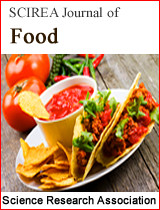Study of Natural and Artificial Radioactivity in some Food Grains
DOI: 490 Downloads 11819 Views
Author(s)
Abstract
Background: Food is indispensable to human life, thus an important parameter of environmental science. The presence of radionuclides in food grains poses a number of health hazards, especially when these radionuclides are deposited in the human body, through food. The main objective of this study is to determine the radioactivity concentration of gamma emitting radionuclides e.g. 238U, 232Th, 40K and gross alpha, gross beta activity in food grain sample. Method: Fifteen samples of food grain were collected from the different market of Dhaka City, six samples were domestic (Bangladesh), and nine samples were imported from different country. The food grain samples were prepared and analyzed by High Purity Germanium (HPGe) and Zinc Sulphide Scintillation Detector, ZnS(Ag). Results: The measured radioactivity concentration of 238U, 232Th, 40K ranges from 7.53 to 35.17 Bq.kg-1 with an average of 22.12±0.14 Bq.kg-1, 4.53 to 30.38 Bq.kg-1 with an average of 14.5±0.09 Bq.kg-1 and 17 to 232.3 Bq.kg-1 with an average of 145.79±0.57 Bq.kg-1. The gross alpha activity and gross beta activity under investigation ranges from 2.72 to 261.77 Bq.kg-1 with an average of 71.07±1.7 Bq.kg-1 and 36.81 to 351.94 Bq.kg-1 with an average of 164.3±11.28 Bq.kg-1. Conclusion: This study will helpful to prepare the data for the activity concentration of gamma emitting radionuclides and gross alpha & gross beta radioactivity in food grain, which will be used to compare the activity level of radionuclides in different type of food grains.
Keywords
Radioactivity, food grains, High Purity Germanium (HPGe) and Zinc Sulphide Scintillation Detector, ZnS(Ag).
Cite this paper
Jannatul Ferdous, Projit Roy, Aleya Begum, M. Habibul Ahsan,
Study of Natural and Artificial Radioactivity in some Food Grains
, SCIREA Journal of Food.
Volume 1, Issue 1, October 2016 | PP. 1-14.
References
| [ 1 ] | UNSCEAR (2000) United Nations Scientific Committee on the Effects of Atomic Radiation, Sources and effects of ionizing radiation, vol. 1, New York, United Nations Publication. |
| [ 2 ] | Venturini, L and Sordi, GAA (1999) Radioactivity in and Committed effective dose from some Brazilian foodstuffs. Health Phys, 76: 311-313. |
| [ 3 ] | Kessaratikoon, P. and Awaekechi, S. (2008). Natural radioactivity measurement in soil samples collected from municipal area of Hat Yai district in Songkhla province, Thailand. KMITL Sci, J., Vol. 8, No. 2 (Section A) |
| [ 4 ] | IAEA (2003). Extent of environmental contamination by naturally occurring radioactive material (NORM) and technological options for mitigation. Technical Repost Series No. 419. International Atomic Energy Agency, Vienna. |
| [ 5 ] | UNSCEAR (2000). Sources and effects of ionising radiation. United Nations Scientific Committee on the Effects of Atomic Radiation, United Nations, New York. |
| [ 6 ] | Desideri, D., Meli, M. A. and Roselli, C. (2010). Natural and artificial radioactivity determination of some medicinal plants. Journal of environmental radioactivity. Vol. 101, No. 2010, Pp. 751-756. Doi: 10:1016/j.jenvrad.2010.04.018. |

